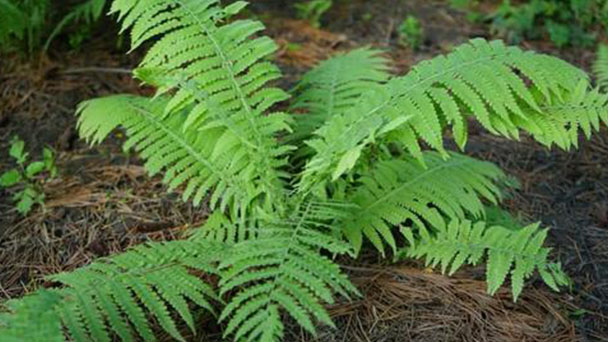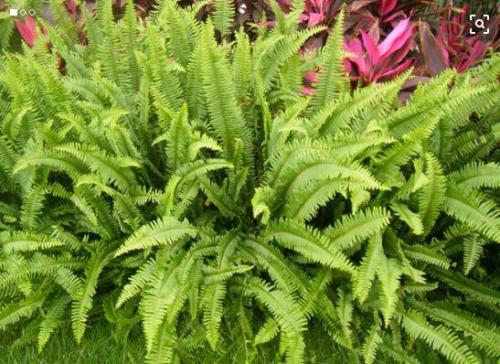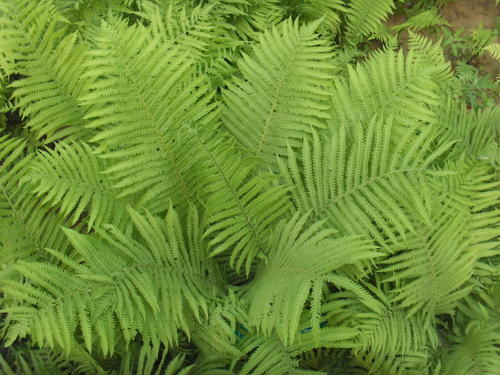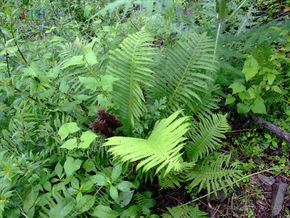Ostrich fern (Matteuccia struthiopteris) profile
Written by Maggie
Mar 20 2021

Ostrich fern (Matteuccia struthiopteris) belongs to the Pteridaceae family. Ostrich fern likes to grow in the coniferous and broad-leaved mixed forests, shrubs and shallow rivers on the wetland.
Ostrich fern plant height is 90 cm. Rhizome is erect, with densely lanceolate scales at the base of the petiole. Leaves are fascicled, dimorphic, stipitate;Sterile leaf blade rectangular oblanceolate, two back deep fissure .Many pairs of lower pinnae gradually shorten downward into small ears. Fertile leaves are short, erect, once pinnate, papery, recurrently encrusting cysts downward. The sporangia are round.
Ostrich fern has fresh cucumber fragrance, rich in protein, fat, carbohydrates and a variety of vitamins, is a famous mountain wild vegetable. It has the same medicinal value as ferns.
Its root and rhizome contain pornasterone A, ecdysis sterone, sphenoid sterone and mianma fine, can make "Guanzhong" medicine, have the effect of clearing heat and detoxifying, cool blood to stop bleeding, drive insects; Its curly undeveloped young leaves can be eaten as mountain vegetables in spring, called "Guangdong cuisine", because of the delicious smell of cucumber, so the name of cucumber fragrance.
Ostrich fern picture

Ostrich fern info
| Botanical Name | Matteuccia struthiopteris |
| Common Names | ostrich fern |
| Plant Type | Fern |
| Sun | Partial shade, full shade |
| Hardiness Zones | 3 to 7 |
| Flower color | Non-flowering |
| Native Area | Europe, eastern Asia, eastern North America |
| Mature size | 3.00 to 6.00 feet high, 5.00 to 8.00 feet wide |
Morphological characteristics of ostrich fern
Rhizome
Ostrich fern plants are 70-110 cm tall. Rhizome is stout, short and erect, woody, hard, dark brown, densely scaly with base of petiole; Scales is lanceolate, 4-6 mm long, apex fibrous, membranous, entire, brown, often brownish to blackish-brown in middle when old.
Leaf
Leaves are clustered on Ostrich fern, dimorphic:Infertility leaf petioles HeZongSe, 6-10 cm long, thick 5-10 mm, with longitudinal groove depth, base triangular, keel calyx, densely covered with scales, upward gradually thinning, leaf blade elliptic, lanceolate to oblanceolate, 50-100 cm long, 17 to 25 cm wide, central to the base gradually become narrow, the second deep plume, 40-60 to pinna, alternate or nearly opposite, oblique, 1.5 2 cm distance, the lower the base gradually narrowed into small ear shape, central pinna is the largest, lanceolate or linear lanceolate, 10-15 cm long, 1-1.5 cm wide, apex acuminate, sessile, pinnate deep crack, Ostrich fern has 20-35 lobes, slightly oblique, close to each other, arrange for regular dentate, elliptic or nearly a rectangle, with big, under central 5-8 mm long, round head or blunt, margin wavy crenate or nearly entire, usually slightly revolute, veins, for feather on lobes, small single pulse, oblique upward, grass leaf mass, green or brown when dry, glabrous, only along rachis, rachis and main veins thin soft hairy and small scales, scape light brown or brown straw color, with vertical shallow groove; From infertility to yukon/short, thick long handle (12 ~ 20 cm long, lower crude 5-12 mm), leaf blade of Ostrich fern is oblanceolate, 20-40 cm long, more than 4 to 8 cm wide, central one feather, feather linear, on both sides of the intensity of the rolled pods, moniliform, dark brown, package sori hemispheroid, small pulse apex into vesicles, located in between scape and leaf edge, sorus rounded, connection as linear when mature, indusium membranous.
Ecology of ostrich fern
Ostrich fern has strong adaptability to temperature and is distributed between 22o and 52O north latitude. Ostrich fern is not sensitive to the length of sunshine, but it requires higher soil moisture and air humidity. Therefore, it is mainly distributed under forests, on both sides of mountain streams and in wet valleys, and no Ostrich fern is distributed in arid areas. Light intensity and soil had a great influence on the growth and development of Ostrich fern. Through investigation, it was found that the coverage was highly correlated with the growth and development of vegetative leaves and sporophylls. In a certain range, with the increase of coverage, the number of vegetative leaves and sporophylls decreased, and the ratio of vegetative leaves and sporophylls increased. Under the condition of dark brown soil as the substrate, the growth situation was better and the biomass accumulation was larger. In short, Ostrich fern like humid, shade resistance, cold resistance, warm, like humus and higher moisture content of the neutral soil.
Ostrich fern cultivation
Ostrich fern has strong adaptability, cold resistance and early resistance. Ostrich fern can be cultivated on the open ground in the north, and can be potted for ornamental use.
Choose canopy shading under the forest cultivation, first remove the forest, branches, stones, deep soil, with a sieve over soil, remove gravel, take fertile loam or leaf soil and mixed with, with farm fertilizer, deep turn 20 to 25 cm, fine leveling, do bed. Field cultivation, choose flat land, good water and fertilizer conditions, fertile soil, good permeability plots for planting. Ostrich fern likes shade, sudden or continuous high temperature, will make the fern water lose, causing heat damage, summer shade shelter to maintain a humid environment.
When potting, use 3 parts of loam and 1 ~ 2 parts of leaf rot soil to mix, and can be mixed with some coarse sand to facilitate drainage and ventilation. Basin soil should not be too wet, generally every 2 ~ 3 days watering once, but should pay attention to foliar spraying.Spring and early summer are the peak seasons for growth, so fertilizer and water management should be strengthened. Winter such as moving into the greenhouse, maintaining 8 ~ 10℃ above, can be evergreen. The soil planting requirements are not strict, the management can be extensive, suitable for planting in the sparse forest.
Water is very important to Ostrich fern cultivation, to meet the requirements of fern soil water and air humidity, the principle is to water less, see seedlings, see the temperature of watering, not watering the soil, often on the foliar water, cleaning the tip of the foliar, keep the foliar clean and humidity. Frequent weeding and shoveling to carry out normal production management.
1. Loose soil weeding
After planting seedling growth, should be timely loose soil weeding, make soil loose, had better be in a soil surface layer, shop a sawdust, already protect moisture and reduce unripe grass.
2. Top dressing
Topdressing nitrogen fertilizer once in early May, and watering after application; When the seedlings of Ostrich fern are withered in autumn, manure or compost can be used to protect the seedlings through the winter and lay a foundation for the next year's growth.
3. Watering
Ostrich fern likes shade wet, often keeps soil moist, nursery stock grows exuberant, be helpful for root and stem natural divide plant reproduction, had better install small sprinkler irrigation, and can increase air humidity at the same time.
4. Harvesting and processing
Ostrich Fern uses roots as medicine. After autumn leaves dry or before spring germination, dig out the rhizome, cut the petiole, fibrous roots, wash the soil, dry in the sun.
5. Ostrich fern houseplants
Thinking of bringing this exclusive searching bit of nature indoors? Ostrich fern houseplants do properly as lengthy as their outside developing prerequisites are met. Keep them out of direct mild and maintain them moist. Be organized even though for an occasional dormant season the place your plant desires time to rejuvenate. Ostrich fern houseplants want lots of water and humidity ranges that are greater than what is typically determined indoors. Misting will help.
6. Ostrich fern fiddleheads
Once you recognize how to develop ostrich ferns and have a proper mattress established, you may choose to attempt harvesting fiddleheads for a springtime dinner treat. Fiddleheads are the first ostrich fern shoots to exhibit in the spring and are so known as due to the fact of their resemblance to the neck of a fiddle. These are the sterile shoots that will develop into the biggest fronds. Pick no extra than 1/2 from every crown whilst they are small and tightly curled. Before cooking, wash them cautiously and do away with the brown papery covering. Fiddleheads can be boiled or steamed and are a unique deal with when sautéed in bacon drippings with a bit of garlic. Make certain to cook dinner them fully and use solely ostrich fern fiddleheads. Fixing a hassle location with lush and stunning increase and imparting an in any other case high priced delicacy for your springtime table, all whilst wanting very little care, ostrich ferns can be the perfect answer for filling that damp, shady spot.

Ostrich Fern propagation
The spore propagation
Autumn spores collection: when Ostrich says fern spores of the leaves from green to yellow brown, looks like the selection of robust plants, take sporophyll, air-dried after crushing, screening out the sporangium, stored at 0 to 5 ℃ temperature of the refrigerator, fully flush with sterile water before sowing, exhibition in a sterile paper, such as sporangium after dry, cracking, pop-up mature spores.
Preparation of medium: mixed peat soil, dark brown soil and river sand in a ratio of 5 parts :3 parts :2 parts, mixed thoroughly, and sifted into mixed soil. The cleaned coarse river sand, stones, seeding containers and mixed soil were steam sterilized separately for half an hour.
Vegetative propagation
Vegetative reproduction, i.e. around the plant, produce more seedlings by roots, usually in the spring and autumn period and the two seasons points strains, autumn, occurrence peak foliage April begins to grow in spring time, choose the roots developed, robust plants, Ostrich fern digging up soil, keep the root is complete, or will be maternal dug out at the same time, according to the size of plant roots and longitudinal cut into several pieces, but need to take root to take Ostrich fern survival, increases with the increasing the seedlings planted. On the whole bed surface, dig holes according to the row spacing of 40 cm, plant L plants in each hole, compaction after covering soil, in order to increase the contact between rhizome and soil, and then water. The seedlings will survive in 3 to 5 days.
Ostrich Fern's distribution area
Ostrich fern is found in Northeast China, North China and Shaanxi, Sichuan, Xizang.
Ostrich fern uses
Edible value
Young leaves of Ostrich fern are edible and rich in vitamins, which are the best of wild herbs. Wild herbs are more and more valued as "sanitary vegetables" that are not polluted by the environment. Young leaves of Ostrich fern can be salted and frozen to keep fresh. Northeast China has been exporting to neighboring countries for decades, and has gained a large amount of foreign exchange for China. Cucumber flavor can also be used to fry meat, it is very good.
Medicinal value
Ostrich fern is one of the five main types of Chinese tuanzi. The roots and stems contain various medicinal ingredients, bitter taste, cool nature, small poison, and have the effect of clearing heat, detoxification and hemostasis.
Ornamental value
Ostrich fern is cultivated in the open air as a foliage plant. Ostrich fern leaves are green, graceful, give people a pleasant feeling, and are a good leaf viewing plant, and have a high ornamental value, popular with visitors.

Latest Updated
- Benefits of Bugleweed - 7 Science-backed Health Benefits
- Bugleweed Dangers & Side Effects - Is It Poisonous?
- How to Plant Evergreen Trees - What You Should Know
- When to Plant Evergreens - Grow Guide for Evergreen Trees
- 12 Wonderful Evergreen Shrubs for Your Garden
- 12 Popular Evergreen Plants with Pictures for Beginners
- When And How To Prune A Lilac Bush Like a Pro
- How to Grow & Care for Lilac Vine (Hardenbergia Violacea)
- Japanese Lilac Tree (Syringa Reticulata) Care & Propagation Guide
- Shumard Oak Pros and Cons - What to Know
Popular Articles
- Winter maintenance of Antirrhinum Majus
- How to Grow Terminalia Mantaly Tree
- How to Grow and Care for Crossostephium Chinense
- How to grow Antirrhinum Majus in spring
- Peristeria Elata (Dove Orchid) Profile: Info & Care Guide
- Underwatered Snake Plant (Sansevieria Trifasciata) - Signs And How To Fix
- How to Care for Brazilian Jasmine Plant (Mandevilla Sanderi)
- How to Grow & Care for Graptopetalum Purple Delight in Summer
- Rosa Chinensis (China Rose): Plant Growing & Care Tips
- How to Care for Baby Sun Rose (Aptenia Cordifolia)